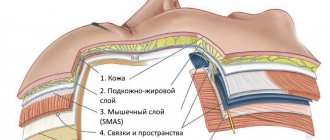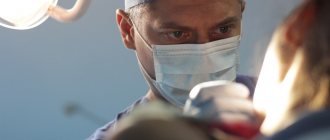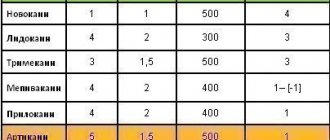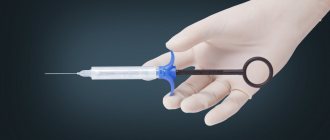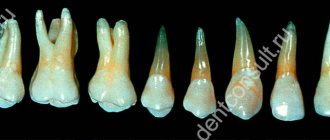For patient comfort, dental extractions and some types of dental treatment are performed under anesthesia. This allows operations and therapeutic procedures to be performed painlessly.
In some patients, the decrease in sensitivity occurs only in the area where the anesthetic drug is administered, while in others it spreads to adjacent tissues - lips, cheeks, chin.
Normally, the effect of the anesthetic lasts several hours. How much exactly depends on the type of anesthesia:
- for infiltration – 3-4 hours;
- for conductor – 5-6 hours.
If the feeling of stiffness does not go away the next day after visiting the dentist, we may be talking about paresthesia.
Why does paresthesia occur?
Decreased sensitivity in various parts of the body is called paresthesia. In dentistry, this pathological condition is associated with nerve damage.
Numbness after tooth extraction most often occurs if a wisdom tooth has been removed. This is due to the fact that the roots of the “eights” are located close to the nerve, which can be damaged due to:
- Traumatic tooth extraction (with its abnormal structure).
- Compression due to postoperative tissue swelling.
- Inaccurate actions of the dentist when administering an anesthetic.
Paresthesia most often occurs in patients over 25 years of age. Other factors that increase the risk of developing pathology include:
- history of neuralgia;
- cardiovascular pathologies;
- diseases of the endocrine system (including diabetes mellitus);
- lack of vitamins and minerals in the body;
- weak immunity.
Signs and symptoms
Complications after tooth extraction are indicated by long-term symptoms that persist for a week or more:
- Lack of sensitivity in a certain area of the face.
- Numbness of the tongue.
- Burning and tingling.
- Weakness of the jaw, inability to close the teeth completely.
- Partial or complete loss of taste.
- Increased salivation.
Hematomas and swelling after surgery
Surgery is not a regular medical procedure. This is a kind of trauma, with damage to mucous and bone tissues. As a result of the physiological reaction of the body's defense systems, there is an influx of lymphatic fluid, which helps the operated area to regenerate and recover. It manifests itself as internal swelling of the oral mucosa, swelling of facial tissues. Hematomas are possible as a result of damage to blood vessels.
Long-term large-scale operations are complicated by the need to stay with your mouth open for a long time. Muscle spasms and pinching of the maxillary joint are likely. It can be difficult for the patient to adapt - muscle tension is felt, it is difficult to chew and speak. This is a normal, explainable condition; traditionally, rehabilitation lasts 7-14 days, in some cases up to a month.
For patients who want to quickly get rid of postoperative discomfort, our Center offers an accelerated rehabilitation program. A complex of injection and physical procedures reduces swelling, eliminates bruises, reduces pain, and completely eliminates micro-spasms of the muscles of the face and neck.
We
do not use outdated punitive surgical
. We have not used drills, hammers and chisels since 2012. Work with bone tissue is performed using ultrasonic piezo technology with minimal trauma. For patient comfort, all operations are performed in medicated sleep.
Levin Dmitry Valerievich Chief physician and founder of the Doctor Levin center
Despite gentle technologies, tissue injury cannot be avoided in any case. The body's reaction to intervention is an understandable natural process. The “brightness” of the manifestation is individual and depends on the volume of the operation performed and the characteristics of the body. For example, representatives of the fair sex are more prone to swelling than men.
Course and combination of procedures
The effect of injection and physiotherapy procedures is enhanced when they are combined due to different mechanisms of influence on the regenerative forces of the body. The rehabilitation program is compiled individually depending on the size of the swelling and the “brightness” of pain:
- For minor surgical interventions, just one injection procedure of PRP or MesoSculpt C71 on the day of surgery is sufficient. The swelling begins to gradually subside within 1-2 days, depending on the depth of the injury. For muscle tension, microcurrents are prescribed after 2-3 days. If the swelling does not go away by this time, another injection procedure is performed in the complex on the same day. If necessary, microcurrent therapy is prescribed again after 2-3 days.
- If there was global surgery , the physiological swelling and discomfort are many times greater. You will need 1-2 procedures with one of the injectable drugs (D-NUCLEO or MesoSculpt C71) and 1-3 microcurrent sessions. The course of physiotherapy depends on the degree of muscle spasm. In some patients, the feeling of tightness, muscle tension, and clicking in the joint persists for up to 2 weeks. In this case, a course of 5 sessions of microcurrent therapy will be required with an interval of 2-3 days.
Indicative rehabilitation programs:
| Symptoms | Medium scale surgery | Global surgery |
| Small/medium edema, hematomas |
|
|
| Small/medium swelling, hematomas + microspasms |
|
|
| Extensive swelling and hematomas |
|
|
| Extensive swelling and bruising + microspasms |
|
|
If you have a meeting, wedding ☺️ or other important event today, the rehabilitation course will help you look presentable in 1 hour!
Prices for services
Simple permanent tooth extraction from RUB 2,000.
Complex permanent tooth extraction from RUB 3,000.
Tooth extraction with detachment of the mucoperiosteal flap from RUB 3,500.
Inspection after removal 0
Removal of 1st supernumerary tooth from RUB 3,000.
Removal of a dystopic tooth from RUB 4,500.
Removal of impacted and dystopic teeth from RUB 5,000.
Removal of a tooth fragment from RUB 1,000.
Initial doctor's appointment 0 rub.
Reviews of doctors providing the service - Wisdom tooth removal
I would like to express my gratitude to the dentist Elena Nikolaevna Kiseleva and her assistant Svetlana - they are real specialists and at the same time sensitive, not burnt out by years of practice.
Thanks to them, I have been coming back here for many years. Thanks to the management for such doctors! Read full review Svetlana Nikolaevna
13.08.2021
I am very grateful to Evgeniy Borisovich Antiukhin for removing my three eights. Especially considering that the lower tooth was not the simplest (it was located in an embrace with a nerve). The removal took place in 2 stages, one tooth under local anesthesia, two under general anesthesia. I had no idea that wisdom teeth could be... Read full review
Sofia
28.12.2020
What is a wisdom tooth
In everyday life, wisdom teeth are the third molars, or the last, eighth teeth in a row, that is, “eights.”
The upper third molars can vary in shape and size, and are usually smaller than other molars and lower 8s. They have two or three roots, which sometimes grow together into one. But they always have three channels.
The lower wisdom teeth can also vary in shape and size, but, as a rule, they are larger than the upper “eights”. The roots of these teeth are short, sometimes fused, and often have a curved shape.
What is included in the complex of restorative procedures
The rehabilitation course allows you to return to a full life - walking, going to work the next day after surgery of any complexity
The procedures are aimed at improving the patient’s condition - reducing swelling, bruising on the face, and pain. Internal swelling goes away, due to which patients often bite their cheeks or simply cannot eat normally.
Lymphatic drainage
The main effect of lymphatic drainage injections is the normalization of lymph and blood flow in the operated area. The composition of multicomponent preparations includes a complex of nucleotides, peptides, vitamins and microelements. By improving blood circulation and accelerated lymph outflow, swelling is minimized and hematomas are resolved.
We use only original certified drugs:
- D-NUCLEO UNO (Israel) Biostimulator, biological product. Contains a complex of PDRN polynucleotides, which increase collagen production and improve cellular metabolism. In addition to the lymphatic drainage effect, it has a powerful anti-inflammatory effect.
- MesoSculpt C71 (USA) Hypothermal drug, lipo-modifier. Contains a component responsible for the restructuring of fat cells. Activates lymph flow, improves skin condition, tightens facial contours due to restructuring of intracellular metabolism.
The D-NUCLEO UNO ampoule contains 3 mg of the drug, which is enough for the entire lower third of the face. Most often used in global operations:
- multiple and total implantation
- bone grafting and sinus lifting in the area where 3-5 implants are installed
- bilateral sinus lift and osteoplasty
- combined surgery
- revision of the maxillary sinus, removal of foreign bodies, removal of tumors
MesoSculpt C71 contains 1 mg of the drug in a syringe, used for smaller interventions that were performed in one segment:
- removal of 1-2 teeth of varying degrees of complexity in one area
- single or segmental implantation
- unilateral sinus lift or osteoplasty
Both drugs have a similar principle of action, have unique regenerative properties, promote rapid recovery and healing of wounds in the oral cavity by nourishing the surgical area, relieve swelling and pain. The cosmetologist selects the optimal one for each patient depending on the volume of manipulation.
Injection procedures are performed immediately after surgery while the patient is still under sedation. There are no traces left from the injections; the cosmetologist uses a very thin needle to prick the external nasolabial triangle or the surgical site locally. If repeated manipulation is required, an anesthetic gel is first applied for 15 minutes, so the patient does not feel pain.
PRP therapy
PRP therapy (plasmolifting, plasma therapy) is also an injection procedure. Platelet-rich blood plasma is used as a stimulating substance, which triggers regeneration processes.
Platelets release various growth factors for capillaries and fibroblasts, resulting in tissue healing faster. Cells of the immune system are attracted, the local defenses of the body are strengthened, this gives a powerful anti-inflammatory effect. Plasma therapy is also used to accelerate lymph and blood flow, minimize swelling, and lighten bruises.
Plasma concentrate is obtained from the patient's blood. While he is still under sedation, blood is drawn from a vein. The plasma is separated by centrifugation in a test tube. The cosmetologist punctures the surgical area externally; usually 1-2 tubes are enough.
The procedure is suitable after non-global surgical interventions, which usually involve minor swelling:
- simple removal of one or two teeth
- installation of one implant
- fixation of the healing abutment
- gum plastic surgery
Microcurrent therapy
This is a physiotherapy procedure, performed in our Center using the Biolift 8806 Gezatone device (France).
Thanks to the effect of low-frequency microcurrents on all layers of the skin, the functional activity of cells improves, blood circulation increases, lymph flow normalizes, metabolic processes accelerate, and the synthesis of collagen and elastin increases. After microcurrent therapy, swelling and hematomas decrease.
Microcurrents have a stimulating and strengthening effect on muscles, restore facial tone, and relieve muscle tension. A person can open his mouth in a normal state without pain, eat well and talk calmly.
Since the procedure has a versatile effect, it can be used after any surgery associated with swelling and bruising. It helps especially well after long-term operations associated with muscle spasms and disruption of the TMJ due to a long stay in an uncomfortable position with an open mouth.
Microcurrent therapy is painless - an anesthetic gel with hyaluronic acid is first applied. The session lasts 20-30 minutes and feels like a facial massage in a spa.
It can be performed on the day of surgery, but it is better after 2-3 days - it is on these days that the pain worsens. The patient better understands what difficulties he has (muscle spasms, poor mouth opening or hyper-swelling), and the cosmetologist understands which areas need more work.
MamonovaAlina Aleksandrovna
Cosmetologist, 3 years of experience
He is fluent in the techniques of injection and hardware procedures. Draws up an optimal course of rehabilitation, taking into account the degree of postoperative defect, based on its causes.
Make an appointment




